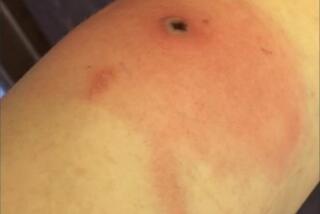A mysterious case of Zika raises new fears of person-to-person transmission

Experts from the Centers for Disease Control and Infection are investigating a worrisome case of Zika virus transmission after the caregiver of a Zika-infected patient who died was found to be infected as well.
In late June, an elderly Utah resident who had visited a country where the Zika virus was widely circulating died. Lab tests showed the patient, who suffered from other medical conditions as well, had a viral load more than 100,000 times higher than that usually seen in people infected with Zika.
A family member who had cared for the patient was also discovered to be infected, prompting the CDC’s investigation.
The family member recovered quickly after a mild illness, as is expected. But how the caregiver contracted the infection remains a mystery.
See the most-read stories in Science this hour »
Unlike the deceased person — referred to by investigators as “the index patient” — the caregiver had not visited an area where the Zika virus was known to be circulating. Nor had the caregiver had sexual contact with anyone known to be infected with the virus.
Of the 1,306 cases of Zika infection that have been reported in the United States, nearly all are thought to have been transmitted outside the U.S. by the bite of an Aedes egypti mosquito. In 14 cases, transmission was by sexual contact with an individual who was infected outside the country. A single case has been deemed an accidental laboratory infection.
Two mosquito species capable of carrying and transmitting the Zika virus are known to be circulating in some tropical corners of the U.S. But so far, no case of infection here is thought to have originated in the country. And no Zika-infected mosquitoes are believed to have reached Utah.
“This is a very unique situation that we haven’t previously seen,” said Dr. Satish Pillai, who is leading the CDC’s Zika Response team in Utah, in a news conference Monday. “There’s a lot we don’t know about Zika virus and we are still doing a lot of investigation to determine whether Zika can be spread from person to person.”
That would be a potentially ominous development in the unfolding epidemic. Since its arrival in Brazil in 2013, the virus has plowed through several Latin American countries where populations have no immunity to it. Transmitted by two strains of mosquitoes — Aedes egypti and Aedes albopictus — the Zika virus has sickened millions with a mild illness characterized by rash, muscle aches and mild fever. In rare cases, infection leads to a potentially deadly complication called Guillain-Barre syndrome, in which the peripheral nervous system comes under attack, causing temporary partial paralysis.
For pregnant women, the bite of a Zika-carrying mosquito has come to be especially feared. The virus can cross the placental barrier and infect a developing fetus, often causing miscarriage or severe brain abnormalities. To date, Zika has been linked to the birth of some 1,600 babies with microcephaly — a condition in which a newborn’s head and brain are stunted and unusually small.
In recent months, researchers have learned that Zika virus lingers in blood, semen, saliva, urine and breast milk and could, in principle, be transmitted through any of those fluids. Just last week, researchers documented a case of sexual transmission in which a Zika-infected woman infected her male partner.
Still, no one is certain that the list of potential transmission sources is complete. Nor do researchers know whether the Zika virus is robust enough to stay alive in, say, tiny particles of saliva that might linger in the air after an infected person has breathed, coughed or sneezed.
“The new case in Utah is a surprise, showing that we still have more to learn about Zika,” said Dr. Erin Staples, a medical epidemiologist with the CDC who is among the investigators probing the mysterious case.
“Nonsexual spread from one person to another does not appear to be common,” she added.
But in light of the new case, apparently, that cannot yet be ruled out. It is still unclear whether the index patient’s high level of infection was the cause of death or whether the patient’s immune system was compromised by other medical problems, allowing the virus to replicate uncontrollably.
CDC investigators dispatched to Utah to get to the bottom of the unexplained transmission will test other people who came in contact with the index patient for infection. Researchers also will collect samples of local mosquitoes to determine whether they might now carry the Zika virus. Pillai and his team suggested they will also need to explore how the patient’s bloodstream came to have such high levels of the virus as well as whether the patient’s unusually high viral load might have facilitated person-to-person transmission.
CDC team member Dr. Michael Bell, a medical epidemiologist, called it “extremely unlikely” that Zika could be spread through the air. “We don’t have evidence right now that Zika can be passed from one person to another by sneezing, coughing, hugging, kissing or sharing utensils,” he said.
But, Bell added, the investigation is still in its early stages. “We don’t want to put the blinders on and go down just one avenue of investigation.”
In the meantime, Bell said, healthcare workers should continue to adhere to standard precautions that guard against the transmission of most viruses, including avoiding contact with patients’ blood, mucus membranes and other bodily fluids and guarding against needle sticks.
Follow me on Twitter @LATMelissaHealy and “like” Los Angeles Times Science & Health on Facebook.
MORE IN SCIENCE
To avoid conflict, L.A. mountain lions choose separate hunting grounds
A woman spread Zika virus through sex in first documented case
Some earthquakes on San Andreas fault are triggered by gravitational tug of sun and moon







